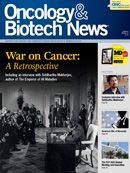Publication
Article
ASH 2010: Bosutinib Shows Promise as First-line Treatment of Chronic Myelogenous Leukemia
Author(s):
Bosutinib (SKI-606) seems poised to join the tyrosine kinase inhibitors (TKIs) imatinib (Gleevec), dasatinib (Sprycel), and nilotinib (Tasigna) as a first-line therapy option for patients with chronic myelogenous leukemia in the chronic phase.
Bosutinib (SKI-606) seems poised to join the tyrosine kinase inhibitors (TKIs) imatinib (Gleevec), dasatinib (Sprycel), and nilotinib (Tasigna) as a first-line therapy option for patients with chronic myelogenous leukemia (CML) in the chronic phase (CP), according to trial results from the phase II BELA (Bosutinib Efficacy and Safety in CML) study. Although the study did not meet its primary endpoint regarding the rate of superior complete cytogenetic response (CCyR), it was not inferior to imatinib on this endpoint and proved superior on other endpoints, according to investigators.
Before the recent approval of nilotinib and dasatinib in the first line, imatinib was the gold standard for first-line treatment of CML. A proportion of patients, however, experience disease progression on imatinib and others develop intolerable adverse effects. Bosutinib is an oral, low-molecular weight competitive inhibitor of Src and ABL, but the novel agent has minimal activity against imatinib targets of platelet-derived growth factor receptor and c-KIT. Phase I and phase II studies have shown that bosutinib is tolerable and clinically active in CML-CP, and it is effective as a second- or third-line therapy for patients with most BCRABL mutations, excluding the T315I and V299L mutations.
BELA, a randomized, phase II, open-label study, enrolled 502 patients with newly CML-CP. Patients were randomized to bosutinib (n = 250) or imatinib (n = 252). According to lead author Carlo Gambacorti-Passerini, MD, professor of internal medicine, University of Milano Bicocca, Monza, Italy, a significantly greater percentage of patients in the bosutinib arm than in the imatinib group achieved major molecular response (MMR) at 1 year. An intentto- treat analysis found a 39% rate of MMR in the bosutinib group compared with 26% in the imatinib arm (P = .002). In addition, time to MMR was significantly superior with bosutinib compared with imatinib (37 vs 72 wk, respectively; P <.0001). In the bosutinib group, 70% of patients achieved CCyR versus 68% of patients in the imatinib cohort. As was the case with MMR, time to CCyR was much shorter with bosutinib than with imatinib (12.9 vs 24.6 wk, respectively; P <.0001).
The drugs had somewhat different adverseevent profiles in this study. The most frequently reported adverse events in the bosutinib group were diarrhea (66%), nausea (27%), vomiting (25%), and rash (18%). In this group, the most frequent grade 3 and 4 adverse events included diarrhea (8%) and rash (2%). No patient discontinued bosutinib because of diarrhea, but more patients taking bosutinib discontinued therapy as a result of adverse events compared with patients taking imatinib (25.4% vs 13.5%, respectively). Imatinib therapy was more commonly associated with muscle cramps, bone pain, and periorbital edema.
“These results [with bosutinib] are like beating a Ferrari. We have shown that we can reduce the number of treatment failures with bosutinib compared with imatinib,” said Gambacorti-Passerini. He emphasized that the most important take-home message of this study is that bosutinib was associated with far fewer treatment failures than imatinib. At 1 year, 3% of bosutinib patients and 10% of imatinib patients had failed on treatment, translatable to an overall net benefit of 7% with bosutinib use. This represents 500 patients with newly diagnosed CML-CP in the United States annually.
“Although bosutinib achieved responses faster than imatinib, this is not as important as reducing treatment failure,” Gambacorti- Passerini said. He added that the research team is now looking for ways to identify those patients most likely to benefit from first-line bosutinib. “We believe that these are patients with more genetic heterogeneity…In addition to the Philadelphia chromosome abnormality, they have other mutations all over the genome. We are doing genomic sequencing on leukemic cells to try to identify patients that will fail on imatinib who can benefit from bosutinib,” Gambacorti-Passerini explained.
Bosutinib is not yet approved in the United States or Europe. Pfizer said the company plans to file for approval of the drug in previously treated patients with CML based on positive findings from Study 200, which are also being reported at the meeting.
___________________________________________________________________________
Gambacorti-Passerini C, Kim DW, Kantarjian HM, et al. An ongoing phase 3 study of bosutinib (SKI-606) versus imatinib in patients with newly diagnosed chronic phase chronic myeloid leukemia. Presented at: 52nd ASH Annual Meeting and Exposition; December 4-7, 2010; Orlando, Florida.










